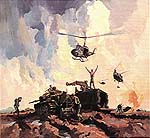
"Max Pedersen"
RAEME IN THE NAVY
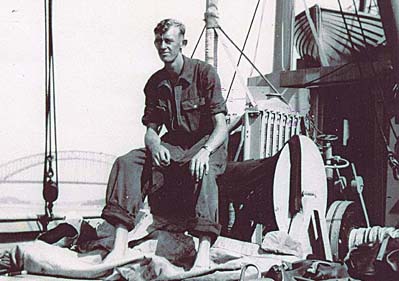
More on Max as aviator — click here
My boss Bluebell at 1 Armd Regt LAD, Capt Bill Gallant, called me in one day and said,"You have a choice. What would you prefer to be posted to Malaya, or go on a RAN Diving School for 6 weeks."
Having been given time to think about this, I elected to go diving. — I must say that I pondered for a while as to whether they wanted to lose me in the wilds of Malaya or drown me in Sydney Harbour because under normal circumstances you don't get a choice.
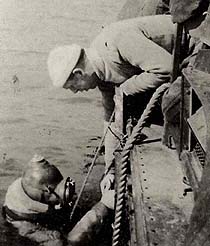 K. Corrigan-Houston (Instr) with R. Bond in Salvus kit
K. Corrigan-Houston (Instr) with R. Bond in Salvus kit
To my joy my fellow army divers were none other than Ken Corrigan Houston and Max Pederson under whom I had recently completed a 2nd Class Recovery Course at RAEME Training Center which involved some diving with Ken as the divemaster.
This was done in the Hume Weir out of the D.U.K.W. (a US amphibian truck of WW2 vintage) so we were to a minor degree prepared for what was ahead of us.
We arrived at H.M.A.S Rushcutter, Sydney on Australia Day, 1955 (I think).
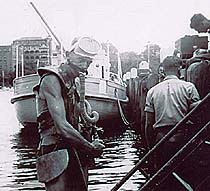
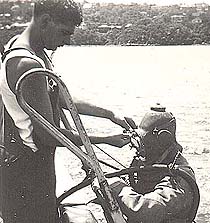
We found the "Q" man, got our gear squared away, and headed for the canteen, where to our surprise we found 4 navy personnel, with one sitting splat bang in the middle of the bar, in swimming trunks, eating a plate of fish. We ordered our drinks, and the elected barman said " Who's got the glass". I will leave it to your imagination as to what followed.
The following morning is into it day — the first task to find out who has a weak heart.
This is done by each member being given a heavy weight, in the form of a back pack full of heavy unknowns, and something to carry in his hands. The idea is to run around the parade ground for an hour, give or take; if you survive that, you don't have a heart condition and you qualify to go to see the naval medical officer.
Obviously we weren't the only personnel on this course. The total complement was in the order of roughly 10 naval ratings and 3 army personnel, With 2 main instructers and a fully crewed diving boat. I almost forgot, they had diving suits as well.
Our dive area was in ever beautiful Sydney Harbour — beautiful on top — on the bottom, a mess (cans and all sorts of rubbish lay in the mud).
Our course was classified as a shallow water diving course, normally of four weeks duration but with an extra two weeks for us to fulfill the additional requirements laid down by the Army.
The first few days were taken up with the theory of diving, safety protocol, familiarisation with equipment, and learning how the place operates.
The diving equipment we were to use is called Salvus diving equipment primarily used as an escape apparatus for drowned submarines. Its use is for depths of around 13 metres. It uses medicinal oxygen as a breathing medium with a bottle lasting for approximately an hour — however usage is forty minutes with the remaining twenty reserved as a safety factor. This may not seem to be a great depth attained but the role of our recovery mechanics is to clear beaches of equipment drowned on off-loading from Landing Ships and the like. An example of this is of course the Normandy landing in which Ken Corrigan played a role. See also Sandy Tocock's article
Cumbersome diving equipment had no place with this type of work. The average person uses approximately 2 litres air flow per minute — this flow can be set and controlled on the equipment. However with controlled breathing, less air is needed enabling an extension of dive time. The above equipment could be used with, or without, the diving suit. (For our purposes a diving suit could be used also on straight compressed air.) We used this equipment on a day to day basis,
- climbing over wrecks,
- crawling through mud on the bottom,
- inspecting the bottom of shipping for damage and compiling sketches of same.
- We scraped the propellers of the battle class Warramunga alongside Garden Island.
- One particular night a massive storm blew up and a passing ship lost a lifeboat. The navy was asked to find and recover it. After calculating tides and wind etc. we found the runaway and brought it to shore at Garden Island.
Daily we would go to the torpedo factory at Neutral Bay to take on diving air, then head for the area we were to work in. Lunch was always enjoyable, as we were forced to sit out on deck eating steak and onions – no chardonnay – but we learnt to enjoy ourself after a while. No hotboxes.
What about those who could not tolerate being underwater and those who when they arrived at the top were bleeding profusely from nose and ears and unable carry out the allocated tasks — These people were never denigrated because that's just the way it is. The navy had a practice that any man suffering these problems was marched out of the School back to his Ship that day. Fortunately we three army bods came through without any problems. Of the Navy bods, I think approximately four left us early.
I did not emerge totally squeaky clean. While I was diving on a wreck in Taylor's Bay with full suit and weights, my hoses became entangled — a navy diver came down and untangled me. That was bad enough but the practice is for the rescuer to hold down a valve on top of victim's suit — the suit takes in a lot of air and away you go, like a cork, out of control to the top.
The final component of the course consisted of underwater welding and cutting, splicing ropes, and various tasks all in the mud — not seeing a thing, with every thing done totally by feel.
The use of a cutting torch underwater is a pretty noisy exercise as you could well imagine and was sure to attract any self respecting shark or what have you. Stingrays were the most worrisome , as they just lay in the mud. One of the navy instructors came across one in the mud off Garden Island its barb went through his suit and into his chest —he was pretty sore for a while.
The navy would lower a metal stage to the bottom. On this was an anvil – various hammers – pieces of steel wire rope that had to be cut with hammer and chisel – shackles with their pins loose in a tray which had to be assembled – and various other acts of unfriendliness
. Each man was allocated a tray which had been lowered to the sea floor. Each diver wore steel diving boots because weight was needed to stay on the bottom. He had to get in, find a tray to start work. You can imagine what it was like, not able to see in the murk, stumbling over others who had already established themselves and started work.
We thoroughly enjoyed the experience of working in the sunshine on Sydney Harbour. From my point of view it was far better than pulling tanks and the like out of the mud, working through the night to get some tankie back on track the next day — while he, all the time, dozed the night away.
We three graduated from the school all chuffed with our experience.
Some months later Ken Corrigan decided to leave the Army and I was posted to RAEME Training Center to work with Max Pederson as a Recovery Instructor.
We kitted out an old D.U.K.W. with an oxy hose running from a filter connected to the vehicle's compressor. We modified a gas mask by blanking it with copper plate. We used this by having a liberal amount of air flowing past the diver's face so he could take air on demand. This type of thing became the Hooker Unit which is in vogue in the diving world today.
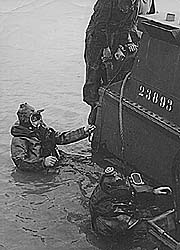
[Beach Armoured Recovery Vehicle]
Instructors on BARV
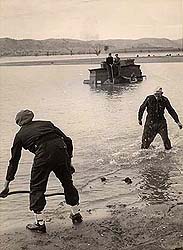
When Max was posted I was left holding the Chief Recovery Instructor's job. I ran another Second Class Recovery Course which went down very well, except that we only had two diving suits — at anyone time two suited students would be on the bottom with the instructor in regulation blue working clothes swimming in water from melted snow.
